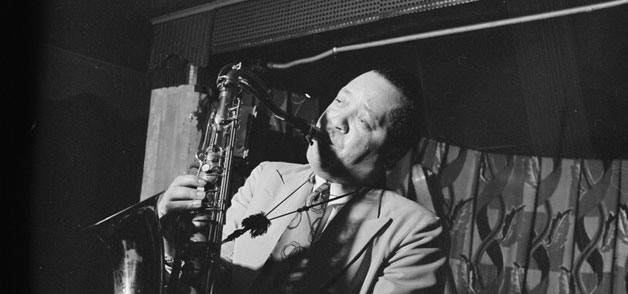9 Classic Saxophone Solos for Transcription Newbies
 This guest post is from saxophone and multi-reed player, composer, recording artist, and educator Sam Sadigursky of SamSadigursky.com
This guest post is from saxophone and multi-reed player, composer, recording artist, and educator Sam Sadigursky of SamSadigursky.com
One of the best ways of building your ears and learning the jazz vocabulary is to transcribe solos by the masters. It’s one of the few things that, in some form or another, just about every jazz player has done and often continues to do over the course of their development. It’s amazingly effective, especially when done mindfully of more than just the notes that you hear. Aiming to match the time feel, articulation, sound, and inflection can be very helpful in your quest to eventually craft a sound of your own.
As I’m sure you know, there are loads of books of transcribed solos on the market. Perhaps the most famous saxophone transcription books is the Charlie Parker Omnibook, which is where many of us were told to start on our jazz quest. These books can be great for improving your reading and extracting some basic vocabulary, but tempting as they are to purchase in lieu of doing your own transcriptions, they will never be as effective as actually transcribing a solo yourself.
One of the biggest stumbling blocks that I’ve encountered with students I’ve taught and met over the years is that they often don’t know where to start with transcribing. You may love John Coltrane, Sonny Stitt, or Michael Brecker, but they are out of the league for most people just starting to transcribe. Students should aim to find solos that are relatively simple and clear and over tunes that they know the chord changes to. Most importantly, make sure it’s a solo you really love, because if you’re new to this, you’re probably going to live with it for quite a while, and it might just stick with you for a lifetime too. I can still sing many of the solos I transcribed as a kid, even if I haven’t listened to the recording in years.
I thought it might be nice to compile a list of jazz saxophone solos that are a good launching point for students. This is but a very short list and I’d love to see some other suggestions from other readers, so please feel free to add your own contributions in the comments section.
For some very good advice on the transcription process, visit this link: http://www.wilktone.com/?p=87.
The Solos (in no particular order)
1) Lester Young’s Solo over Blue Lester from “The Immortal Lester Young”
http://www.youtube.com/watch?v=6pte1tm61g8
Blue Lester is a bluesy minor blues sort of tune with a section in major key. Lester’s swing and note choice are totally infectious.
2) Sonny Rollins solos on “St. Thomas”
Truly immortal solos from the master. The motivic development on display here is one of a kind. This one is a bit more uptempo and a bit more challenging than some of the others listed here.
3) Phil Woods’ solo on Billy Joel’s Just the Way You Are
http://www.youtube.com/watch?v=hjCoBTzrN9E
Bebop plus pop music doesn’t always make for a winning combination, but in this case, Phil Woods scores a home run with this tasteful and lyrical classic solo on a hip tune with pretty chord changes.
4) Stan Getz solo over “Girl from Ipanema” from Getz/Gilberto
http://www.youtube.com/watch?v=-pyoP0iA_k0
No matter how many times I’ve heard this in elevators and hotel lobbies, the Getz solo blows me away.
5) Dexter Gordon solo from “Second Balcony Jump” from Go
Simple and swinging. Not a commonly played tune, but the changes are quite simple.
6) Paul Desmond solo over “Take Five” from Dave Brubeck’s Time Out
Hearing and playing over the 5/4 time signature could be tricky for some, but well worth the effort, and the fact that this solo is modal should make it easier to deal with.
7) John Coltrane solo over “My Shining Hour” from Coltrane Jazz
A great solo over a familiar tune that should be a staple for jazz players. A little bit more of a challenge then all the others, but his execution is quite clean and rhythmically straightforward.
8) Lou Donaldson’s solo on “Blues Walk”
http://youtu.be/CRIINONjJ-M
A low-medium tempo minor blues with a simple and bluesy solo that grooves nice n’easy.
9) David “Fathead” Newman’s tenor solo on Ray Charles’ Unchain My Heart
http://www.youtube.com/watch?v=PA_s3VbSHLA
Short, sweet, and simple. More advanced students may even want to try transcribing this one without paper.
Study with Sam
Sam Sadigursky is currently offering online lessons through Skype and private lessons in NYC. He has given improvisation clinics across the U.S., is a regular guest professor at Hunter College, and currently performs internationally with Darcy James Argue’s Secret Society, Folklore Urbano, and others. To find out more, visit SamSadigursky.com.






June 18, 2012 @ 8:13 pm
Any comments on alto players lifting tenor solos (or vice-versa)? Is it destined to be an exercise in frustration as the lines go out of the range of the horn, or worthwhile just the same?
June 19, 2012 @ 4:54 pm
If you like the solo, it’s absolutely worth it, and might be a great way of expanding your range and building your technique. The instances where the tenor is below Eb and actually out of the alto range might be minimal, so most solos should be quite playable.
June 19, 2012 @ 5:12 pm
Thanks. I am an alto player, and a big fan of Cannonball, Sonny Stitt, and all the other alto greats, but often feel that at this stage I’d be best served by lifting a basic Hank Mobley solo, or something similar from that era.
June 19, 2012 @ 7:08 pm
Yes, Hank Mobley solos are some of my favorites. His lines are so clear and so full of great voice leading. If you don’t know it already, check out his solo on “Tenor Conclave,” a rhythm changes tune. Or his solo on “Someday My Prince Will Come” from the Miles Davis album of the same name was actually one of the first things I ever transcribed.
February 10, 2013 @ 11:01 am
Hello,
I would like to know in which key you write your transcription ? I méan i play alto saxophone i heard ténor saxophone in Bb and piano in C, it sourds strange to me.
Thanks
David
February 10, 2013 @ 4:32 pm
I usually simply transcribe in the key of my instrument. So if you hear a note on the recording and it matches, for example, an A on your horn, then you would transcribe that note as an A. You can always transpose later if you want to have the solo for another tune (or better yet, work towards memorizing and transposing the solo without looking at the sheet music at all). :)
July 31, 2013 @ 5:12 am
Great site! Great suggestions! May I add Coleman Hawkins to the list? His solo on ‘You’d be so Nice to Come Home to’ is harmonically rich and very rewarding to study and get to know.
July 31, 2013 @ 1:48 pm
A great suggestion indeed, there’s a lot of vocabulary we get could get from Coleman that we wouldn’t come across in the world of bop and “modern jazz” that so many of us focus on.
April 24, 2015 @ 8:59 pm
As a 30+ year sax player, many styles of gigs—I agree nothing prepares an improvisational saxist like transcribing, and ear learning the great saxists solo’s!!thanks these are excellent ones..i dieted on Stitt, Donalson, Mobley, Dex, Bird , and Trane from 16yrs. old to around 25….please send some to my new facebook page: Creative Improvisational sax, antime!!!!I can be viewed “in action” @ youtube-Preston love Legacy Orchestra Members-2 impromptu video’s-I play more “soulful” on those, but usually “bop” a lot! Peace
October 17, 2019 @ 3:22 am
Excelente compilação de solos!
Além de apresentar-se como um estudo de sax, coloca o neófito em contato com estilísticas diferentes!
June 14, 2021 @ 10:48 pm
I need the tenor sax solos on some motown songs. Who can help?
May 15, 2023 @ 5:37 pm
I would love to have the pdf sheet music for each of the above solos for alto and tenor sax…Please